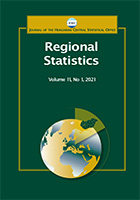Economic and crime cycles synchronization across states in México: A dynamic factor model approach
Economic and crime cycles synchronization across states in México: A dynamic factor model approach
Author(s): Víctor Hugo Torres Preciado, Nelson Omar Muriel TorreroSubject(s): Social Sciences, Economy, Geography, Regional studies
Published by: Központi Statisztikai Hivatal
Keywords: crime trends; economic cycles; robbery; employment; synchronization; dynamic factor models; México
Summary/Abstract: Crime deterrence is of significant importance in public policy in México due to high and sustained levels of insecurity. Traditionally, public policies, including training programs for security enforcement agents and increasing thepolice force, have been implemented under an implicit understanding that economic stress and fluctuations have comparable effects across all territories. However, if the synchronization of the economy and crime has a geographically determined rate, policy makers need to consider these differences to increase policy efficiency. This study determines whether business cycles correlate with robbery cycles among states in México. To analyse these correlations, we implement a General Dynamic Factor Model, as proposed by Forniet al. (2000), which extracts each cyclical component from robberies in the states and from permanent and temporary employment measures. The results reveal the synchronization of a heterogeneous cyclical component among states and between both types of employment, which strongly suggests public security policies should incorporate a regional perspective. Additionally, the monitoring of economic performance should keep pace with public security actions, as this will improve the effectiveness of crime-deterrence actions.
Journal: Regional Statistics
- Issue Year: 11/2021
- Issue No: 04
- Page Range: 3-27
- Page Count: 25
- Language: English

